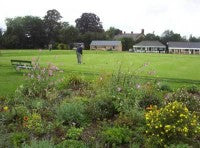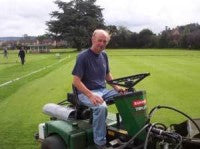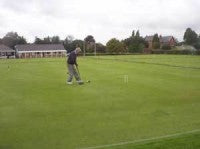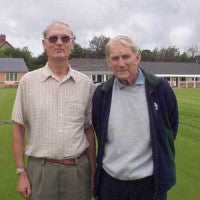Cheltenham Croquet Club.
Cheltenham Croquet Club.
By David Magee & Laurence Gale MSc

Cheltenham Croquet Club was founded in 1869 at about the same time as the Sussex Croquet Club (near Brighton) and the All England Club at Wimbledon, so can claim to be one of the oldest croquet clubs in England. It was established in the Montpellier area of Cheltenham but is now situated on the Old Bath Road adjacent to the East Gloucestershire Club of which it was a part until 1908.
The Club has 11 full size lawns, not to mention a large practice area. With over 200 active members, ranging in age from 9 to over 90, it is regarded by many as the pre-eminent club in the UK.
History of the club

It was certainly helpful that many of the people so influential in advancing the game were in or around Cheltenham at this time. Walter Whitmore Jones, who lived at Chastleton House 20 miles east of Cheltenham, compiled the Field Rules which were published in April 1866 in The Field, the gentleman's weekly newspaper of the day. At much the same time J H Hale, who lived at 2 Lansdown Villas in Cheltenham, was also working on the tactics and format of the game. He was the inventor of the bisque and the Hale setting, which remained in use until superseded in 1922 by the Willis setting that is used today.
Interest in croquet was beginning to wane and the last recorded tournament of that era at Cheltenham was played in 1876. It is hard to appreciate fully, the spectacular rise and sickening fall in the fortunes of croquet. The startlingly rapid decline after the middle 1870's was brought about both by the meteoric rise of tennis and by the self-imposed difficulties of playing croquet.
However, by the early 1900's the game of croquet became popular again with a number of tournaments being played and arranged in and around Cheltenham. In March 1904 fourteen visionaries attended a meeting in the Queen's Hotel that started a process which has led the sport to where it is today. 1907 saw the first moves for Cheltenham to become a truly independent club. The Committee ascertained that the East Gloucestershire Club had no objection to such a move if a meeting of the croquet members showed a majority to be in favour of the idea. A postal ballot was held and the result was 62 in favour, 6 against and 4 neutral. The Club then became a separate Registered Club and a new lease was taken out with the Charlton Park Estate, commencing on 1 October 1908, for a term of 14 years. Then, in 1909, the Annual General Meeting agreed that the name of the Club should become The Cheltenham Croquet Club.

Grounds history
The number of Groundsmen employed to work on the courts has varied over the years. Just prior to the First World War there were four: Warren was employed at 23/- a week throughout the year, Evans received 19/-, F Gibbard had 10/- for work which included care of the pavilion and N Gibbard received 10/- for working from 7 am to 1 pm. During the war, Evans was the only Groundsman employed and the Committee decided to open only four courts with the other four courts put to hay and sheep grazing. Returning the abandoned courts to a playable condition after the war entailed a prodigious amount of work. Molehills and tunnels had to be filled in, tussocks of coarse grass and large weeds dug out and the turf re-laid in many places.
The work took three years to complete and it was not until 1922 that all ten courts were open for play. Between the wars the Club employed two Groundsmen, but Slater, the assistant Groundsman, was called up at the start of the Second World War and the Club agreed it would manage with Harding alone. After the war the Club continued to employ only a single Groundsman, though for many years it seems that the Lawns Manager was effectively an unpaid Groundsman. Col. Wheeler and W Handley seemed to spend as many hours working on the courts as did the Groundsman and, in 1991, the 'threat' of W Handley giving up his unpaid work on lawns made the Committee once again consider the ground staff 'problem'. Since then the Club has employed an assistant Groundsman for two or three mornings a week during the playing season.
The advent of the Second World War also put pressure on court maintenance and in 1943 it was agreed to start the season with only six courts and bring two more into play if required. After the war, eight courts were brought back into use but courts 4 and 5 were left fallow and this practice continued until 1952 when those courts were brought back into play. However, the need to cut costs in 1954 forced the Club again into the practice of only routinely using eight courts. In 1958 the Club tried to start an 'adopt a lawn' scheme but it did not come to anything. This might have been quite fortunate as it precluded any fear of members objecting to others playing on 'their' lawn. The financial problems in the early 1960s forced the Committee to examine all items of expenditure and at one stage they considered leaving four courts fallow, but fortunately the financial situation never got quite bad enough to adopt such a plan.
By the early 1980s it was recognised that many of the courts were becoming rather uneven, and a study in 1992 showed that court 9 had developed severe undulations and some of the other courts had significant problems. In 1993 J D Bradley, the Lawns Manager, produced a '10 year plan of work' that did indeed take ten years to complete. In 1996 the central pathway was raised to help level the inner boundaries, work that had last been done in 1923, and the outer boundaries of some courts were shored up. September 2000 saw the start of the project to re-lay courts 9 and 10 and create a full-size court 11. Unfortunately it started to rain the following month and it was not until September 2001 that the new turf could be laid. The courts were officially opened in April 2002 but there were severe problems with drainage. Whilst conditions on courts 10 and 11 improved substantially throughout 2002, drainage channels had to be laid under court 9.
Some of you may be interested to know what has been applied to the courts over the years. In the early years combinations of farmyard manure, soot, dried blood, lime and bone-meal were the principal applications. These seem to have worked well, as in 1928 the lawns were publicly acknowledged as being the best in the country. In 1964 the Club tried out the application of sludge which they purchased from the depot at St James' railway station but, fortunately, that seems to have been a one-off trial. Most people are probably not aware that court 8 is also the final resting place of two club members. In 1985 George Blumer's ashes were scattered over the court and, during the last day of the Easter tournament in 2000, Ian Maugham's ashes were spread around hoop 1 and the peg. Knowing Ian, I am sure that the situation would have amused him but it did cause a degree of upset, especially for the players at the time who had to try and negotiate the hoop without treading all over him.
Water was laid on to the Club grounds in 1905 and in 1928 Capt Lock and J N Hardy paid for a new main to be laid and the provision of hoses for watering the courts. Manually watering ten courts cannot have been a frequent occurrence and it must be assumed that watering was only done in extremis. In 1987 the Club voted to install irrigation to all 10 courts at a cost of nearly £10,000. Using the bulk of George Blumer's legacy, the work was completed early in 1988 and has since then helped the courts cope with a punishing tournament schedule and some extremely harsh, dry conditions.
The area around where court 11 is now situated has had a varied history. Although there was ample ground available, there does not seem to have been any idea in the early days of building an eleventh court and the area was the site of a small practice area bordered by fruit and flower beds. In 1963 Col Wheeler, the Lawns Manager of the day, regarded the area beyond court 10 as a dangerous liability, owing to its being a source of disease which was spreading to the lawns. He thought the best way to clean the land was to let it to a market gardener but the Committee, in 1964, decided instead to level and re-turf the area with a view to creating an eleventh court. However, the Minutes record that, in 1968, Col Wheeler still wanted nothing to do with the area and that the re-turfing had not improved the quality of the grass. Though the prepared area would still not accommodate a full-size court, the Committee was still of a mind to use the lawn if necessary but the new Lawns Manager, R O B Whittington, did not agree. He warned that there was a great danger of spreading fungus to the courts and that the restoration had to be done carefully and not rushed. He concluded by saying that he was not prepared to accept any responsibility for the lawn. Things quietened down until 1986 when the Committee spent some of George Blumer's legacy on re-seeding and levelling the lawn - then to be called George's Lawn. However, the Committee decided that it would be too expensive to make the lawn full-size, and reasoned that keeping the lawn small would deny its use for tournaments and thus make it always available for members. The lawn therefore remained an under-utilised area until the re-laying programme in 2000 when the court at last became full-size.
Current Maintenance

It took Peter three years to convince the club the benefits of spiking and scarification. None of these operations had ever been carried out at the club previous to Peter's employment.
The club have since recognised the value of good greenkeeping and have been assessing the quality of their lawns/courts by undertaking a series of consultation reports from approved agronomists which, in fact, resulted in the refurbishment of three lawns at a cost of £50,000 in 2002.
The lawns were completely renovated. The works involved stripping off the old turf, power harrowing and re-levelling the existing soil profile. Compatible rootzone soil material was imported and added to restore levels and provide a growing medium for the new turf that was laid over the entire area.
The club proposes to renovate a number of the other lawns in the future when funding becomes available. With over 100 years of play and wear on these lawns, it is not surprising that they have become tired and uneven, with some having a soil pan at a depth of 200mm. Peter usually alternates end of season renovation works, completing renovation work on five lawns one year and five lawns the following year. The main reason for this is mainly cost, however this year he will be renovating all the greens as the Ccub is hosting the World Croquet Championships in 2005.
Another challenge for Peter is the fact that the club remains open during the winter months, allowing members to play croquet on the lawns. However, the club implement a rotation system allowing play on two lawns only at any one time.
Peter generally uses the ride on mower for most of the grass mowing operations but will use the clubs pedestrian Auto Certes when preparing the lawns for championship/tournament matches. He maintains a cutting height of 5mm in the summer and keeps the sward at 8-9 mm during the winter. Fertilising is dependant on soil analysis and generally applied in spring, summer and autumn. Autumn renovations consists of scarifying, spiking, overseeding and top dressing with an application of between 2-3 tons of top dressing material for each lawn/courts (25m x 38m).
Bernard Neal, the current Club president, who has been associated with the club since 1979 is determined to keep up the club's traditions and reputation of being one of the leading clubs in the country, especially now that the sports (Croquet) Governing Body, The Croquet Association, have established their UK headquarters at the Cheltenham Croquet Club. The club currently has over 200 members, both in a playing and social capacity.
 (pictured left Nigel Graves of the Croquet Association and right Bernard Neal the current Club President of Cheltenham Croquet Club).
(pictured left Nigel Graves of the Croquet Association and right Bernard Neal the current Club President of Cheltenham Croquet Club).
The Croquet Association (CA) moved to Cheltenham in 2002 after a long association with the Hurlingham Club in London (1959-2002). Nigel Graves, the secretary of the club, believes that the move to Cheltenham was the right one. The club is one of the oldest and biggest in the UK and at the forefront of the sport. Cheltenham host most of the game's national competitions each year.
The Croquet Association have well over 120 affiliated clubs. The Association receives about 100k in fees from the sport each year, and have to decide on how best to use this money to promote the sport. The overheads of the CA are relatively small with most of the funds put back into actively promoting croquet, organising tournaments and funding club grants.
2005 is an important year for Cheltenham and the CA with the preparations required for the forthcoming World Croquet Championships being held in England, with Cheltenham and a number of other clubs hosting the matches in June.
More detailed history of the club can be obtained from David Magee who has produced a 30 page book on the history of Cheltenham Croquet Club at davidandeileen.magee@btopenworld.com.
For details about Cheltenham Croquet club you can visit their web site at www.croquet.org.uk/
